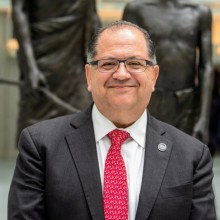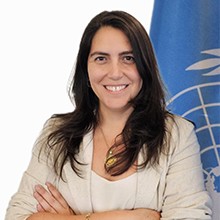Watch the event session recordings under the agenda tab
- OVERVIEW
- AGENDA
- FEATURED SPEAKERS
- RELATED
Co-hosted by the World Bank's Poverty Global Department and the Regional Bureau for Latin America and the Caribbean of the United Nations Development Programme (UNDP), this one-day event explores how complexity science and network-based methods can bring fresh insights to development research and policy. Discover how these tools can help reveal the hidden structures and systemic interactions that shape observed patterns of growth, poverty, and resilience—and how these insights can help inform innovative approaches to integrated policymaking. The event will feature a keynote address by Professor Cesar Hidalgo, followed by a series of presentations applying these approaches to critical areas such as the green transition, the digital economy, multidimensional poverty, and the interlinked nature of development goals.
Date: Monday, May 5, 2025
Time: 9:00am-2:45pm ET
Location: World Bank Group I Building, Room I 2-220 & Online
| 9:00-9:30 | Welcome Coffee | |
9:30-10:30 |
Opening Session: Complexity and DevelopmentWatch the RecordingWelcome Remarks
|
The notion that developing economies benefit from upgrading their productive structure has recently become an important tenet of international development. The growth of this idea follows from work on economic complexity, which shows that machine learning methods provide powerful tools that can be used to create fine-grained measures of economic potential. In this presentation, Cesar Hidalgo will provide a quick overview of economic complexity methods with a focus on their practical applications. He will show examples of how these methods are being used throughout the developing world to navigate present-day tariff uncertainties and to develop long-term developments strategies and analytical capacities. |
10:30-11:15 |
Presentation: Complexity Economics and Computational Methods for Economic PolicymakingWatch the RecordingOmar A Guerrero, Head of Computational Social Science Research, Alan Turing Institute Chair: Almudena Fernández, Chief Economist for Latin America and the Caribbean, UNDP |
Since the 1990s, complexity economics has developed various approaches to analyze economic systems. As computing power and large datasets have become commonplace, the need to move beyond “toy” models and purely data-driven frameworks to develop models that are meaningful for policy intervention has become self-evident. This presentation will provide an overview of two programmes of research that have made significant progress in this regard: one focusing on SDG8 (labour markets) and another on the interdependencies and trade-offs between the SDGs. Useful links: |
11:15-11:30 |
Coffee Break |
|
11:30-12:15 |
Presentation: Measuring the Intensity and Geography of AI-Assisted CodingWatch the RecordingJohannes Wachs, Professor at Corvinus University of Budapest, Hungary (Virtual) Chair: Maria Eugenia Genoni, Lead Economist, Poverty Global Department, World Bank |
If AI coding assistants raise productivity, uneven adoption will widen existing economic disparities. We detect AI‑generated code in the contributions of over 300k developers on GitHub from 2018–2024. By mid-2024, we estimate 26% of code contributed by US-based developers was written using AI, compared with 22% in Germany and France, 18% in India, 15% in Russia, and 10% in China. We find heterogeneity by tenure but not gender, and that AI use increases user activity and exploration. |
12:15-1:15 |
Lunch |
|
1:15-2:00 |
Presentation: Development Acupuncture: The Network Structure of Multidimensional Poverty and Its ImplicationsWatch the RecordingViktor Stojkoski, Researcher, Faculty of Economics in Skopje and the Center for Collective LearningChair: Diego Zavaleta, Senior Advisor on Strategy and Partnerships, UNDP |
Poverty is multidimensional. Despite significant progress in measuring poverty multidimensionally, there is still a limited understanding of how dimensions interact and co-evolve over time—ultimately hindering effective integrated policy making. Using network science and economic complexity methods, this research introduces two measures: the Poverty Space (a network visualizing interactions among poverty dimensions) and Poverty Centrality (which identifies the importance of each dimension). These measures point to key “nodes” in the structure of multidimensional poverty where targeted interventions could potentially lead to a greater effect on the system as a whole. Useful links: |
2:00-2:45 |
Presentation: People, Products & Policies: Charting Adjacent Possible Development Pathways in the Green TransitionWatch the RecordingPenny Mealy, Senior Economist, Climate Change Group, World Bank (Virtual) Chair: Gabriela Inchauste, Practice Manager, Poverty Global Department, World Bank |
How can the green transition be a driver of inclusive development and poverty reduction? This talk draws on the concept of the adjacent possible—the boundary between what is and what could be—to explore feasible and strategic development pathways for people and places on a livable planet. We will look at how workers can transition into better jobs, how countries can capture value from emerging green technologies and global supply chains, and how policy mixes can be strategically designed and tailored to national contexts. |
2:45-3:00 |
Closing remarks from Luis Felipe Lopez-Calva, Director, Poverty Global Department, World BankWatch the Recording |
|
Date: May 05, 2025
Time: 12:18 PM - 12:18 PM ET
Location: Washington, DC & Online



